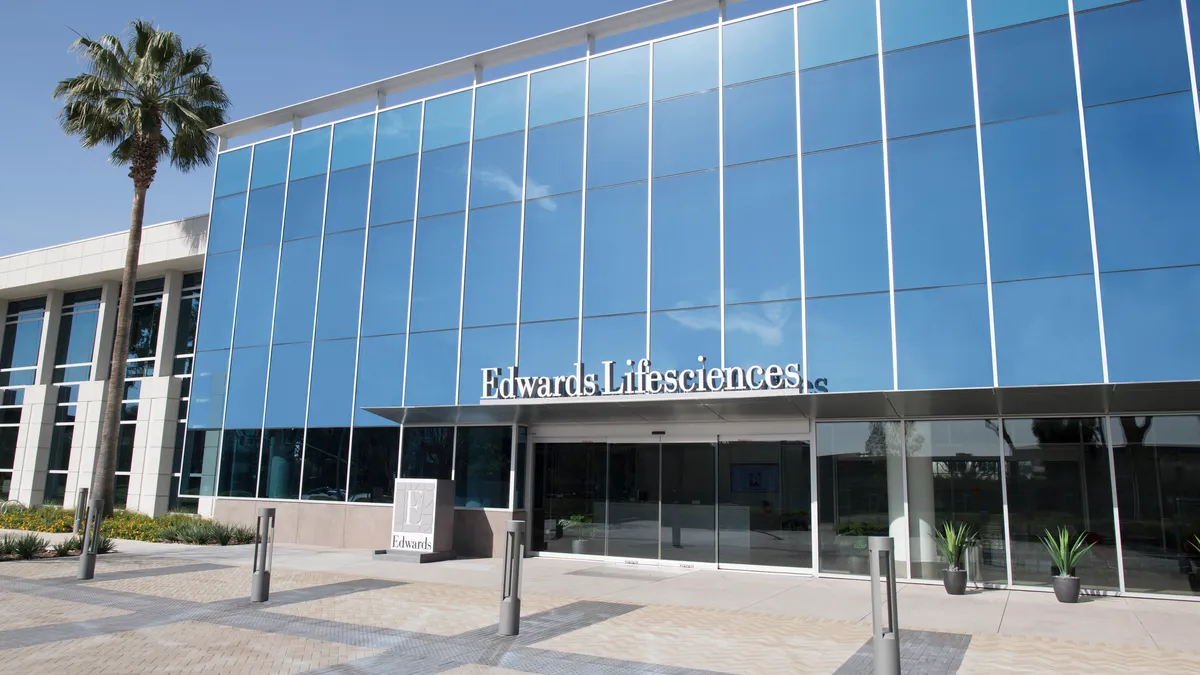Dive Brief:
-
Edwards Lifesciences raised expectations for 2020 transcatheter aortic valve replacement (TAVR) sales in a report to investors Thursday after seeing demand rebound faster than expected amid disruptions from COVID-19.
-
Management said 90% of Edwards’ active sites performed TAVR procedures in May and June, helping sales to come in $25 million above the top end of its guidance.
-
Buoyed by the recovery, Edwards now expects full-year TAVR sales growth of around 5%. Yet, there remain concerns that a slowdown in new patient screenings will be a prolonged brake on growth.
Dive Insight:
Edwards joins a growing list of medtech companies that beat expectations in the second quarter. With analysts expecting sales of around $792 million, Edwards posted revenues of $925 million, exceeding even its most optimistic projection.
The outperformance echoes that of other companies such as Johnson & Johnson and NuVasive. After falling sharply in April, procedure volumes steadily improved in May and June. In the end, TAVR sales in the U.S. suffered a low-teens decline, with other geographies faring slightly better. In response, Edwards said it expects to hit the top end of its -5% to +5% full-year range for TAVR sales. Investors responded favorably to the results, sending shares in Edwards up 5% in after-hours trading.
However, the shape of the long-term recovery remains uncertain. Edwards CEO Mike Mussallem said U.S. sites have largely worked through any backlogs of patients that built up as a result of deferrals due to COVID-19, suggesting the company is now reliant on new referrals for growth.
That could be problematic in the near term. In a note to investors following the call, analysts at William Blair said the new patient pipeline “really slowed” during March and April and “could pose a risk to sustained improvements through the second half of the year and potentially into 2021.” Analysts at Jefferies made a similar point, zeroing in on a shift in Edwards’ language about fourth quarter growth to predict ongoing sluggishness.
“The implication is that the demand side remains weaker—and is expected to remain that way for the next couple of quarters at least,” the analysts wrote in a note to investors.
Mussallem said the mortality rate of patients who forgo TAVR during the pandemic means “patients are highly incented to enter the system” but he has wondered whether the unwillingness of elderly people to go to the hospital will have a protracted impact on demand.
The suppression of demand may be most severe in parts of the country with significant COVID-19 outbreaks. Mussallem said Edwards has received anecdotal reports of TAVR cases being canceled in Texas and Florida. Such ups and downs are built into Edwards’ forecast for a flat third quarter and a return to growth in the fourth quarter.
Edwards is also contending with a slowdown in the addition of new TAVR sites. Before COVID-19, the company said it was on track to grow its list of U.S. TAVR sites from 700 to 850 centers. However, the second quarter results were attributable to existing centers. “I don’t think that new centers were trying to do TAVR during the onset of a global pandemic,” Mussallem said.
Amid the upheaval, Edwards continued to work to ensure it is in a strong position as new patients and centers turn to transcatheter heart procedures. More than half of sites involved in pivotal trials of Edwards’ mitral and tricuspid devices resumed enrollment in the quarter, keeping the company on track to potentially win FDA approval for its rival to Abbott’s MitraClip in 2022.
During the quarter Edwards also won approval to sell its Sapien 3 TAVR device in China. Mussallem cautioned investors to expect a slow ramp up in sales, noting that the presence of local competitors and need for people to pay for the procedure out of pocket makes it hard to calculate the opportunity.










